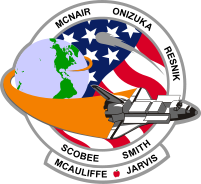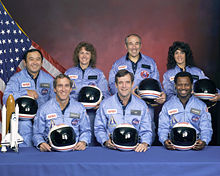STS-51-L
| STS-51-L | |||||
Mission insignia |
|||||
| Mission statistics | |||||
|---|---|---|---|---|---|
| Mission name | STS-51-L | ||||
| Space Shuttle | Challenger | ||||
| Crew size | 7 | ||||
| Launch pad | 39-B | ||||
| Launch date | 1986-01-28 16:38:00 UTC | ||||
| Landing | Did not land, destroyed shortly after liftoff (1986-02-03 17:12 UTC planned) |
||||
| Mission duration | 73 seconds (6 days 34 minutes planned) |
||||
| Number of orbits | Failed to achieve orbit (96 planned) |
||||
| Orbital altitude | 150 nautical miles (280 km) (planned) | ||||
Crew photo Back row (L-R): Ellison Onizuka, Christa McAuliffe, Gregory Jarvis, Judith Resnik. Front row (L-R): Michael J. Smith, Francis "Dick" Scobee, Ronald McNair. |
|||||
| Related missions | |||||
|
|||||

STS-51-L was the twenty-fifth flight of the American Space Shuttle program, which marked the first time a civilian had flown aboard the Space Shuttle. The mission used Space Shuttle Challenger, which lifted off from Launch Complex 39-B on January 28, 1986 from Kennedy Space Center, Florida.
The mission ended in disaster following the destruction of Challenger 73 seconds after lift-off because of the failure of an O-ring seal on Challenger's right Solid Rocket Booster (SRB). The failure of the seal allowed a blowtorch-like flare to impinge upon one of two aft SRB attach struts, which eventually failed, freeing the booster to pivot about its remaining attachment points. Subsequently, the forward part of the booster cylinder impacted the external tank (ET) intertank area, leading to a structural failure of the ET—the core structural component of the entire stack. A rapid burning of liberated propellants ensued. With the structural "backbone" of the stack compromised and breaking up, the SRBs flew off on their own, as did the orbiter, rapidly disintegrating due to the overwhelming aerodynamic forces. Evidence found in the remnants of the crew cabin showed that several of the emergency air supplies (PEAPs) carried by the astronauts had been manually activated, suggesting that the forces during breakup of the orbiter were not inherently fatal and that at least some crew members were alive after the craft broke up.
The tenth mission for Challenger, STS-51-L was scheduled to deploy the second in a series of Tracking and Data Relay Satellites, carry out the first flight of the Shuttle-Pointed Tool for Astronomy (SPARTAN-203)/Halley's Comet Experiment Deployable in order to observe Halley's Comet, and carry out several lessons from space as part of the Teacher in Space Project and Shuttle Student Involvement Program (SSIP). The flight also marked the first American manned mission to involve in-flight fatalities, and the first American manned mission to launch and fail to reach space, the first in the world being Soyuz 18a.
Contents |
Crew
- Francis "Dick" Scobee (2), Commander
- Michael J. Smith (1), Pilot
- Judith Resnik (2), Mission Specialist
- Ellison Onizuka (2), Mission Specialist
- Ronald McNair (2), Mission Specialist
- Gregory Jarvis (1), Payload Specialist
- Sharon Christa McAuliffe (1), Spaceflight Participant (Teacher in Space)
(1) number of spaceflights each crew member has completed, including this mission.
In the event McAuliffe was disqualified from flight, she would have been replaced by her NASA-selected backup, Barbara Morgan.
Crew Fate
No official investigations into the Challenger Disaster have concluded for certain the cause of death of the astronauts, however it is almost certain the actual explosion did not kill the crew, as 3 of the 4 PEAPs (personal egress air packs) were manually activated, which would only be done during an emergency or loss of cabin pressure (although whether cabin pressure was lost or not is still in debate but considered likely). However the PEAPs do not provide a pressurized air flow and would still have resulted in the astronauts losing consciousness within several seconds.[1] There were some famous reports in the media that NASA had a secret tape recording of the crew panicking and on board conversation following the explosion during the 2 minute 45 second free fall before impacting into the sea east of Florida. This was fabricated however and no such recording exists. For starters the crew would have been unconscious from air pressure difference (mentioned earlier) and secondly the astronauts did not wear individual voice recorders.[2] What is certain however is that the impact of the shuttle with the sea would have killed any still surviving astronauts on board, however they may have died prior to the impact of other causes.
Mission objectives
- Deployment of Tracking Data Relay Satellite-B (TDRS-B) with an Inertial Upper Stage booster
- Flight of Shuttle-Pointed Tool for Astronomy (SPARTAN-203)/Halley's Comet Experiment Deployable
- Fluid Dynamics Experiment (FDE)
- Comet Halley Active Monitoring Program (CHAMP)
- Phase Partitioning Experiment (PPE)
- Three Shuttle Student Involvement Program (SSIP) experiments
- Two lessons for the Teacher in Space Project (TISP).
None of the mission objectives were accomplished.
Mission parameters

- Mass:
- Orbiter Liftoff: 121 778 kg
- Orbiter Landing: 90 584 kg (planned)
- Payload: 21 937 kg
- Perigee: ~285 km (planned)
- Apogee: ~295 km (planned)
- Inclination: 28.45° (planned)
- Period: ~90.4 min (planned)
- Duration: 73 seconds (6 days 0 hours 34 minutes planned)
Mission insignia
The STS-51-L crewmembers designed the insignia seen above to represent their participation in NASA's mission aboard Challenger, depicted launching from Florida and soaring into space to carry out a variety of goals. Among the prescribed duties of the five astronauts and two payload specialists (represented by the seven stars of the US flag) was observation and photography of Halley's Comet, backdropped against the U.S. flag in the insignia. Surnames of the crewmembers encircle the scene, with the payload specialists being recognized below. Surname of the first teacher in space, Christa McAuliffe, is followed by a symbolic apple.
See also
- Space science
References
External links
|
||||||||||
|
||||||||
|
|||||||||||||||||